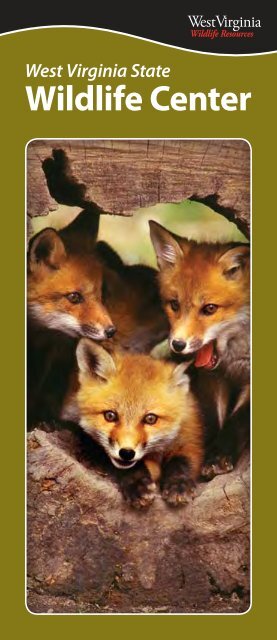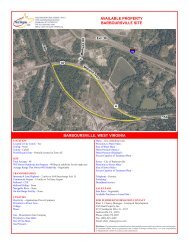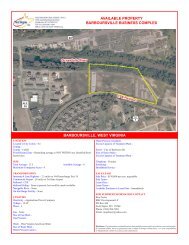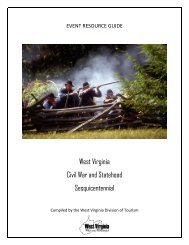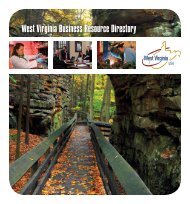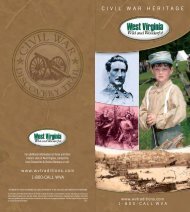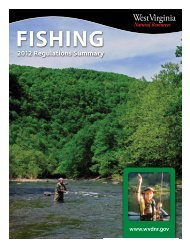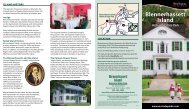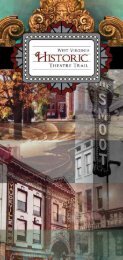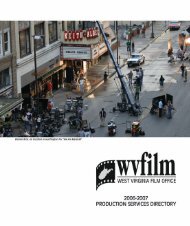State Wildlife Center Brochure - West Virginia Department of ...
State Wildlife Center Brochure - West Virginia Department of ...
State Wildlife Center Brochure - West Virginia Department of ...
- No tags were found...
Create successful ePaper yourself
Turn your PDF publications into a flip-book with our unique Google optimized e-Paper software.
<strong>West</strong> <strong>Virginia</strong> <strong>State</strong><strong>Wildlife</strong> <strong>Center</strong>
FACILITIESThe <strong>Wildlife</strong> <strong>Center</strong> <strong>of</strong>fers the perfect setting formotorcoach tours and school trips. Guided toursare available upon request.Picnic Area• 13 picnic tables• 10 grills• Pavilion: 8 tablesCall <strong>Wildlife</strong> <strong>Center</strong> Office for reservationsFishing Pond• waterfowl viewing• stocked with bass, bluegill,catfish and troutSteve ShalutaGift Shop• refreshments• souvenirsKEYWalkwayFoot BridgeFoot TrailAnimal EnclosureHandicapped AccessFishing PondParking AreaPicnic AreaRestroomsPavillionScale (in feet)Jack MillsJack Mills
HISTORYAlthough the <strong>Wildlife</strong> <strong>Center</strong> is a modern facility,its roots run deep into the annals <strong>of</strong> wildlifeconservation. In the early 1900s, <strong>West</strong> <strong>Virginia</strong>’swildlife populations were in sharp decline due touncontrolled exploitation and habitat destruction.Conservationists began vigorously promoting gamerefuges as a means <strong>of</strong> protecting diminishing wildlife.The <strong>West</strong> <strong>Virginia</strong> Conservation Commission(forerunner <strong>of</strong> the Division <strong>of</strong> Natural Resources)began purchasing land for game refuges inthe 1920s, using funds derived from the sale <strong>of</strong>hunting licenses. The French Creek Game Farm waspurchased in 1923 and used periodically to penraisevarious species <strong>of</strong> game birds and animalsfor restocking projects for the next 29 years. Thisprogram was discontinued when it was proven tobe biologically unsound. Pen-raised animals do notdevelop survival skills necessary for life in the wild.From its beginning, the Game Farm attracted publiccuriosity. Recognizing its unique recreational andeducational value, the Conservation Commissiondeveloped several native wildlife species displaysfor the general public. These wildlife exhibitsproved to be so popular that in the fall <strong>of</strong> 1926,nearly 6,000 people visited the farm.In 1954, one pair <strong>of</strong> elk and bison were obtainedfrom Oklahoma. Elk and bison, which had previouslyroamed <strong>West</strong> <strong>Virginia</strong>, proved to be major attractions.Other species <strong>of</strong> formerly native wildlife, such asthe mountain lion, timber wolf and river otter, havebeen added over the years. The collection <strong>of</strong> exhibitanimals also includes three non-native wildlifespecies that now occur in our state: the Europeanwild boar, ring-necked pheasant and coyote.An entirely new exhibit area was designed andbuilt beginning in 1984. Funding was obtainedusing matching federal monies from the Land andWater Conservation Fund <strong>of</strong> the U.S. <strong>Department</strong><strong>of</strong> Interior. On September 28, 1986, the new facilitywas dedicated and renamed the <strong>West</strong> <strong>Virginia</strong> <strong>State</strong><strong>Wildlife</strong> <strong>Center</strong>.Jack Mills Jack Mills
EXHIBITSOperated by the <strong>Wildlife</strong> Resources Section <strong>of</strong> the<strong>West</strong> <strong>Virginia</strong> Division <strong>of</strong> Natural Resources, the<strong>Wildlife</strong> <strong>Center</strong> is dedicated to presenting visitorsa realistic and factual understanding <strong>of</strong> ourstate’s wildlife. This is accomplished by displayingeach animal in its natural habitat. The spaciousenclosures allow the animals to interact with theirenvironment and exhibit more natural behaviorpatterns. Interpretive signs help the visitor to learnmore about each animal’s life history, biology andits relationship with humans.The large grazers, elk and bison, have acres <strong>of</strong>grass on which to roam. Visitors can enjoy viewingwoodland wildlife by walking along a 1.25-milewheelchair-accessible interpretative trail through amature hardwood timber stand. The mountain lionand timber wolf, formerly the state’s top carnivores,live alongside their principal prey, the white-taileddeer. The state mammal, the black bear, is a featuredattraction. Even the elusive coyote, a recent resident<strong>of</strong> our state, can be seen. Many <strong>of</strong> the state’scommon and not so common small mammals andbirds are displayed in the numerous exhibits.The <strong>Wildlife</strong> <strong>Center</strong>’s most dynamic exhibitshowcases the river otter. This display allows visitorsto view the powerful and amazing swimmingabilities <strong>of</strong> these aquatic mammals from above aswell as below the water’s surface.River otter were nearly eliminated in <strong>West</strong> <strong>Virginia</strong>in the late 1800s. The <strong>Wildlife</strong> Resources Section <strong>of</strong>the Division <strong>of</strong> Natural Resources has successfullyreintroduced this animal back into the <strong>State</strong>.ADMISSIONFees are charged from April 1 through October 31only. Contact the <strong>Wildlife</strong> <strong>Center</strong> at 304.924.6211 forcurrent fees and group rates.Hours9 am – 5 pmWeather conditions may alter operating hours.Jack MillsRon SnowRon SnowRegulations• NO pets• NO alcoholic beverages• NO feeding the animals• Follow all posted regulations


